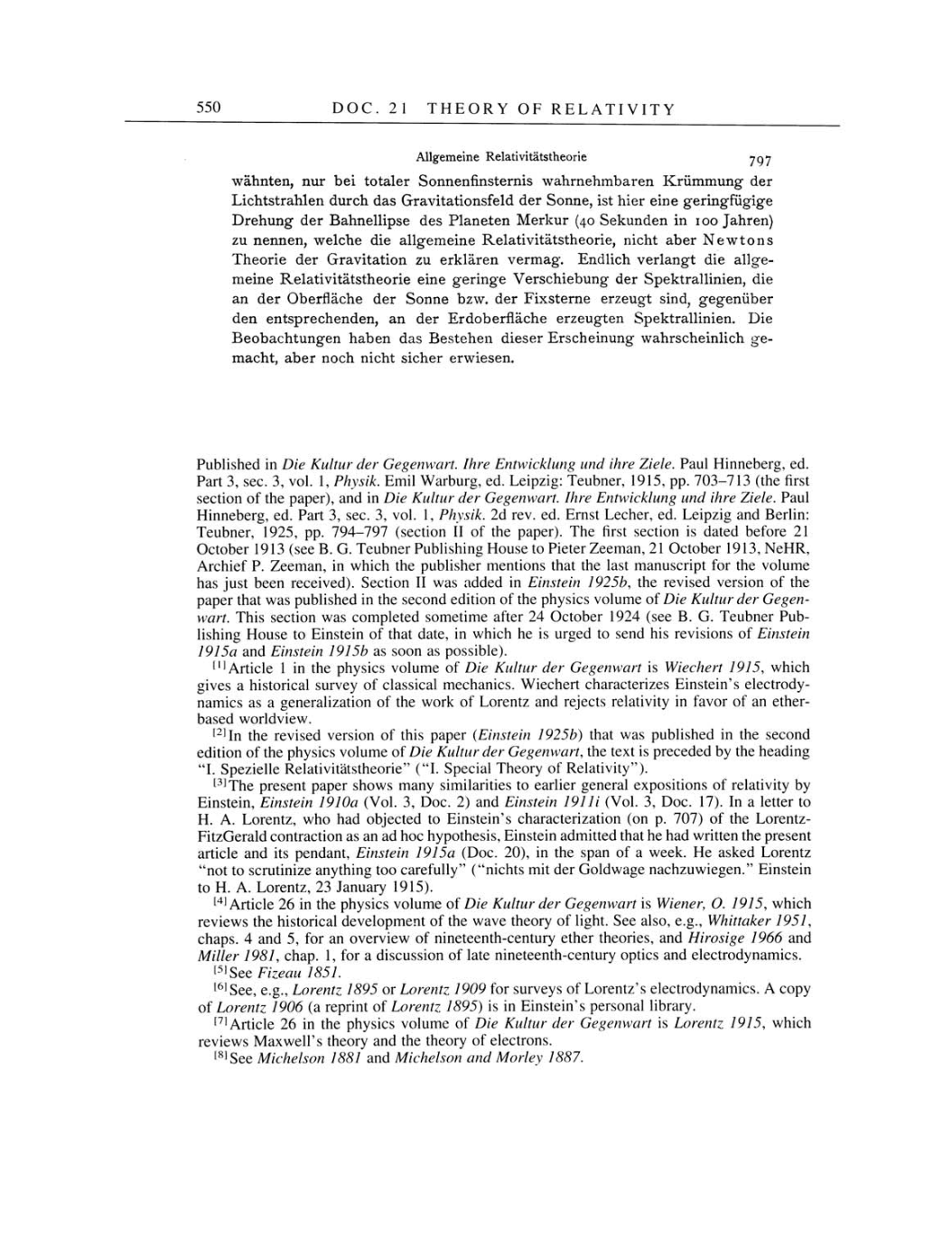550
DOC. 21 THEORY
OF
RELATIVITY
Allgemeine
Relativitätstheorie
797
wähnten,
nur
bei totaler Sonnenfinsternis wahrnehmbaren
Krümmung
der
Lichtstrahlen durch
das
Gravitationsfeld
der
Sonne,
ist hier eine
geringfügige
Drehung
der
Bahnellipse
des Planeten
Merkur
(40
Sekunden
in
100
Jahren)
zu
nennen,
welche die
allgemeine
Relativitätstheorie,
nicht aber
Newtons
Theorie der Gravitation
zu
erklären
vermag.
Endlich
verlangt
die
allge-
meine
Relativitätstheorie
eine
geringe Verschiebung
der
Spektrallinien,
die
an
der Oberfläche der Sonne bzw. der
Fixsterne
erzeugt sind,
gegenüber
den
entsprechenden,
an
der
Erdoberfläche
erzeugten
Spektrallinien.
Die
Beobachtungen
haben das Bestehen dieser
Erscheinung
wahrscheinlich
ge-
macht,
aber noch nicht sicher erwiesen.
Published
in
Die Kultur der
Gegenwart.
Ihre
Entwicklung
und
ihre
Ziele. Paul
Hinneberg,
ed.
Part
3,
sec. 3,
vol.
1,
Physik.
Emil
Warburg,
ed.
Leipzig:
Teubner,
1915,
pp.
703-713
(the
first
section of the
paper),
and
in
Die Kultur der
Gegenwart.
Ihre
Entwicklung
und ihre
Ziele.
Paul
Hinneberg,
ed.
Part
3, sec. 3,
vol.
1, Physik.
2d
rev.
ed.
Ernst
Lecher, ed.
Leipzig
and
Berlin:
Teubner,
1925,
pp.
794-797 (section
II
of
the
paper).
The
first
section
is
dated before
21
October
1913 (see
B.
G.
Teubner
Publishing
House
to
Pieter
Zeeman,
21
October
1913,
NeHR,
Archief P. Zeeman, in
which the
publisher
mentions that
the last
manuscript
for the volume
has
just
been
received).
Section
II
was
added
in
Einstein
1925b,
the
revised version of the
paper
that
was
published
in
the second edition of
the
physics
volume of Die Kultur der
Gegen-
wart.
This section
was
completed
sometime after
24
October
1924
(see
B. G.
Teubner Pub-
lishing
House
to
Einstein of that
date, in
which
he is
urged to
send
his
revisions of Einstein
1915a and Einstein 1915b
as soon as
possible).
[1]Article
1
in
the
physics
volume of Die Kultur der
Gegenwart is
Wiechert
1915,
which
gives
a
historical
survey
of classical mechanics. Wiechert
characterizes Einstein's
electrody-
namics
as
a generalization
of
the work
of Lorentz and
rejects relativity in
favor of
an
ether-
based worldview.
[2]In
the
revised version of
this
paper
(Einstein
1925b)
that
was
published
in the
second
edition of the
physics
volume of Die Kultur der
Gegenwart,
the
text
is
preceded
by
the
heading
"I.
Spezielle
Relativitätstheorie"
("I.
Special Theory
of
Relativity").
[3]The
present paper
shows
many
similarities
to
earlier
general expositions
of
relativity
by
Einstein,
Einstein 1910a
(Vol. 3,
Doc.
2)
and Einstein 1911i
(Vol.
3,
Doc.
17).
In
a
letter
to
H. A. Lorentz,
who had
objected to
Einstein's characterization
(on p.
707)
of
the
Lorentz-
FitzGerald contraction
as an
ad
hoc hypothesis,
Einstein admitted that
he
had written
the
present
article and
its
pendant,
Einstein 1915a
(Doc. 20),
in
the
span
of
a
week.
He asked Lorentz
"not
to
scrutinize
anything
too
carefully"
("nichts mit
der
Goldwage nachzuwiegen."
Einstein
to
H. A. Lorentz, 23 January
1915).
[4]Article
26 in the
physics
volume of Die Kultur der
Gegenwart
is
Wiener, O. 1915,
which
reviews the historical
development
of
the
wave
theory
of
light.
See also,
e.g.,
Whittaker
1951,
chaps.
4 and
5,
for
an
overview of
nineteenth-century
ether
theories,
and
Hirosige
1966
and
Miller
1981, chap.
1,
for
a
discussion
of
late
nineteenth-century optics
and
electrodynamics.
[5]See
Fizeau 1851.
[6]See, e.g.,
Lorentz 1895
or
Lorentz 1909
for
surveys
of Lorentz's
electrodynamics.
A
copy
of
Lorentz 1906
(a reprint
of Lorentz
1895)
is in
Einstein's
personal library.
[7]Article
26 in
the
physics
volume of Die Kultur der
Gegenwart is
Lorentz
1915,
which
reviews Maxwell's
theory
and the
theory
of electrons.
[8]See
Michelson
1881 and
Michelson
and
Morley
1887.
